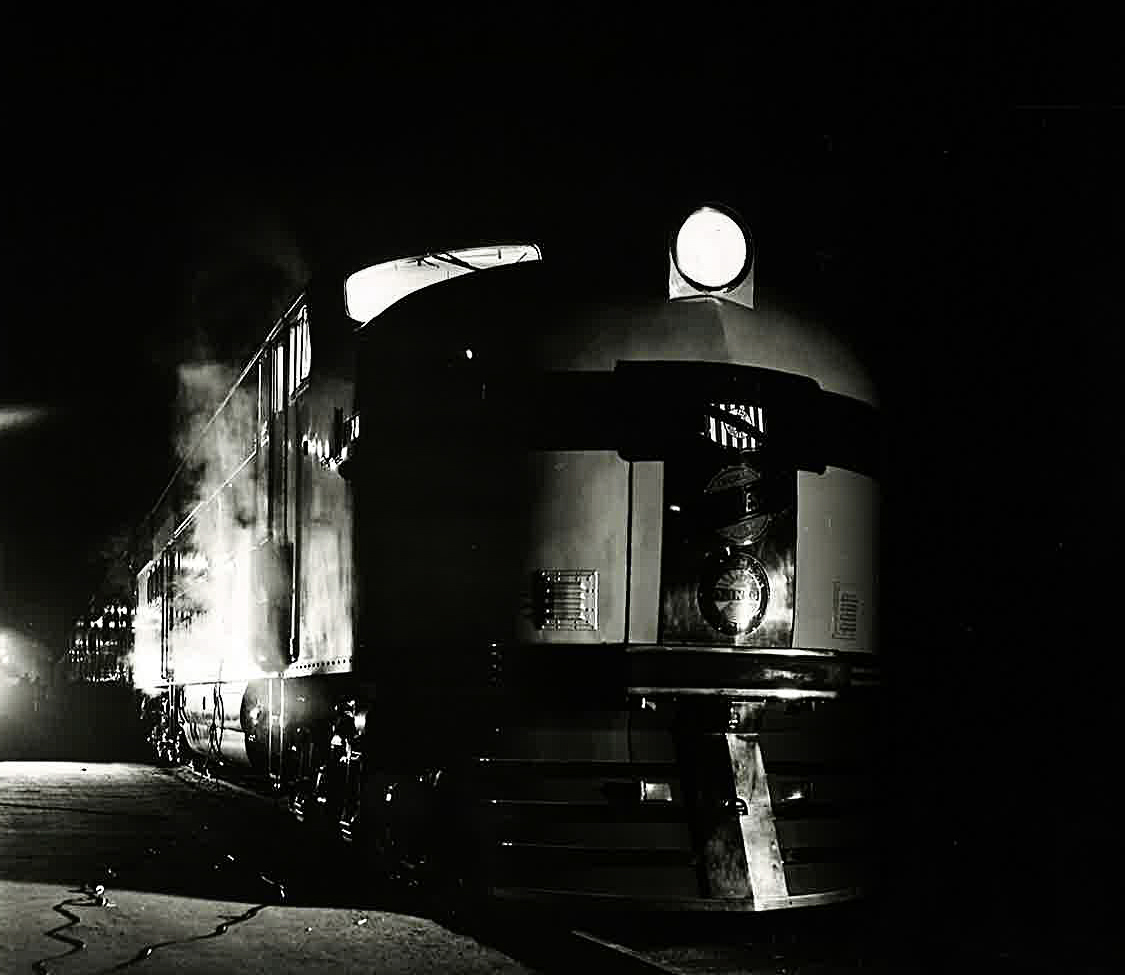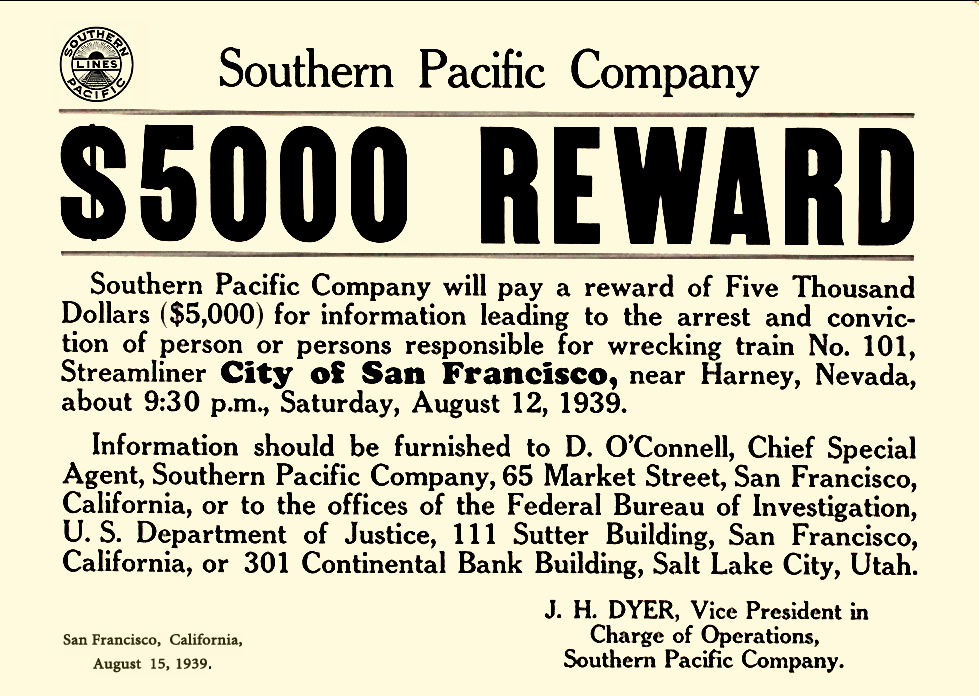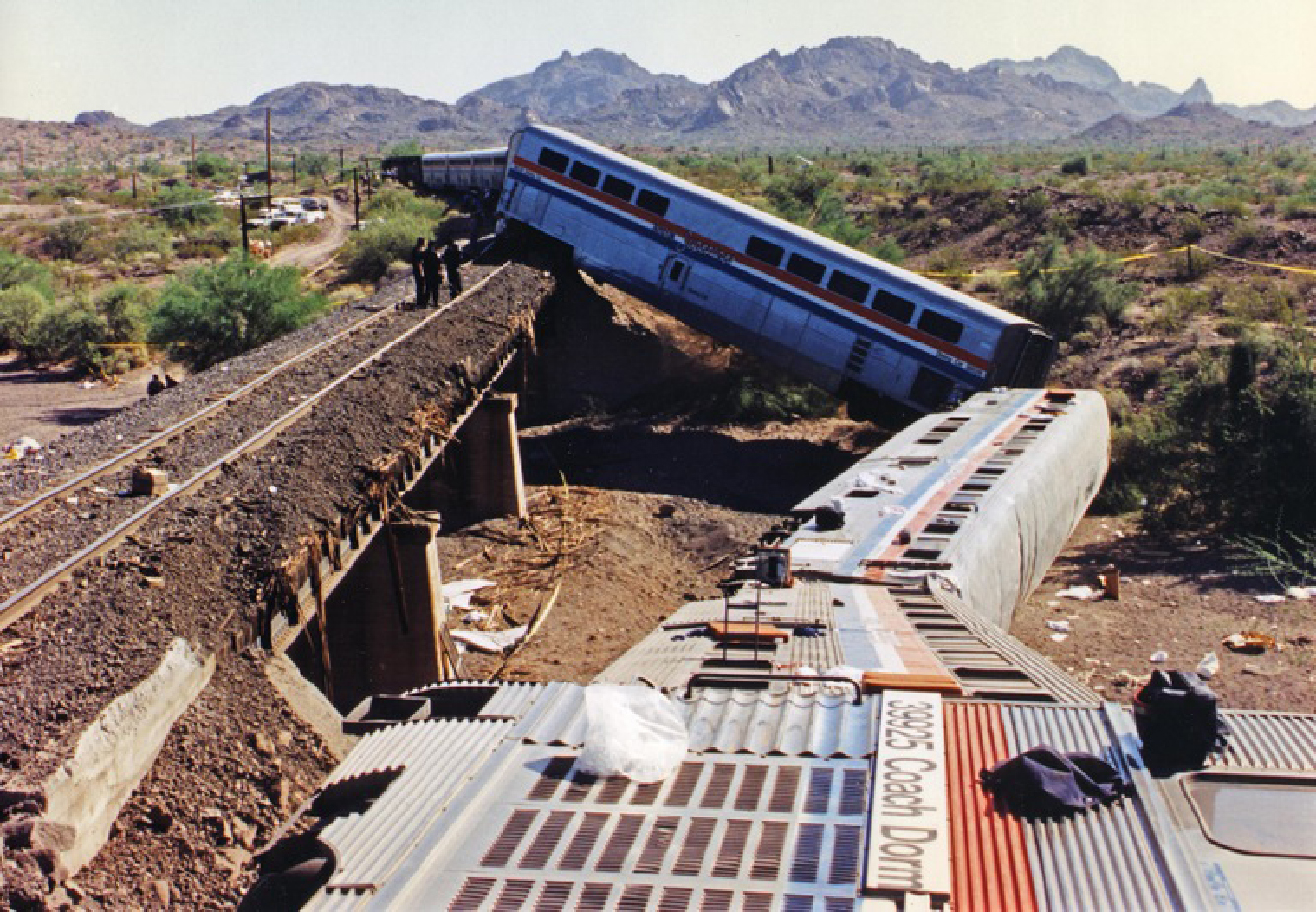A scary tale of two train wrecks: Around the time of All Hallows’ Eve, it is tradition to subject ourselves to dark, scary tales intended to make us afraid of the dark and fear those things that go bump in the night. The vast majority of these stories are pure fiction that, when peeled back, reveal nothing more than a creative storyteller’s adventure at our expense. It can be said, however, that the true stories, the ones that actually happened, are the scariest of all. You be the judge as we experience two scary train wrecks.
Suddenly, he felt his own car lurch and jump the tracks, then thud, thud, thud along the wooden ties across the bridge out of control. Death in all her possible violent agony began.
The huge [train] trembled, rocked, and swayed as steel snarled on rocks and ties. For a split second there was a terrifying rumble similar to a distant earthquake as speeding coaches furiously leaped from the rail. There followed a horrifying roar, as if a thousand freight trains were colliding. Resounding over the flat quiet desert, the roar turned into the screeching, splintering, slashing sounds of crunching steel, as if some fiendish giant were squeezing the train together with his mighty hands. Accompanying this sickening grinding of steel striking metal and rock, tracks being yanked from their ties, metal car walls made of the strongest steel ripped open, folded and crushed, were the sounds of people trapped in the terror. Death could not have chosen a better spot to strike. Out of control, the [train’s] middle coaches snapped their connections with the engines and slammed into the old iron bridge. Cars telescoped into each other, steel crashing and crunching. A dining coach filled with late dinner passengers and retiring waiters and cooks was tossed like a toy replica into the air and landed in a jagged, twisted heap in the river, with a club car nosing down after it; two other cars followed, hurtling against the heavy steel girders of the bridge, while other coaches simply overturned. The heavy, rusty girders of the bridge swayed, then snapped and collapsed like so much cheap tin into the stream below. Five more cars loaded with terrified, panic-stricken men and women toppled down on top of them. The beams of the bridge jutted in every possible angle, like so much matchwood. In the scrap pile of mashed hulls, the once beautiful [train] lay in the throes of agonized death.
Aug. 12, 1939 —
For its time, the City of San Francisco could easily be labeled the most luxurious streamlined passenger train in the West, if not the entire country. The Union Pacific, Southern Pacific, and Chicago & North Western, who operated the Chicago to Oakland speedster ponied up $2 million to have it built ($19.1 million in 2022). Plush Kelly green seats made for a comfortable ride. Polaroid provided a special tinting material for the windows to reduce glare. The EMD E2 A-B-B locomotive set churned out 5,400 hp, enabling the City of San Francisco to rocket across its westbound route in 45 hours, 45 minutes. That’s 19 hours better than previous marks. Beyond the base ticket price and Pullman fees, there was an “extra” fare associated with riding this luxury streamliner — $5 for the chair car, $15 in Pullman open sections and $22.50 in a roomette.
Leaving Carlin, Nev., the City of San Francisco was 30 minutes behind time. Veteran engineer Ed Hecox knew the next long, empty stretch of Nevada would be ideal for making up time. He opened the throttle spurring the train up to 90 mph.
It was 9:33 p.m. when Hecox spotted a large tumbleweed laying across one rail near bridge No. 4 over the Humbolt River. It was unusual and he watched the weed as the train approached. Upon hitting the tumbleweed, Hecox reported that there was a significant jarring felt in the cab. He hit the brakes, but it was too late. The City of San Francisco was in the process of derailing. The locomotives slid forward off the rails. Five cars uncoupled and plunged into the riverbed below the bridge. In that instant 24 passengers were killed and nearly all of the 170 people on board suffered some kind of injury.

The derailment site was desolate. It took hours for the first help to arrive and daybreak the following morning before a rescue train reached the site. Aboard the rescue train were special agents from the Southern Pacific and the FBI. Despite the area around the wreck having been completely disturbed, it was quickly determined that the City of San Francisco had been sabotaged.
Just before bridge No. 4, a 30-foot section of rail had been tampered with. The perpetrator(s) pulled up the spikes on this piece of rail so that it could be forced inward by approximately 5 inches. The tumbleweed was used as a disguise. Additionally, dark brown paint had been applied to the area, further hiding the vandalism. A fast-moving train hitting this large a gap would surely derail in a catastrophic manner.
According to Dan O’Connell, the Southern Pacific’s chief special agent, sabotage of this nature in this location would have taken 90 pounds of tools. The tools had to be carried from the highway over a mile away. The job would have taken several hours to complete. Incidentally, there was a 4-hour window with no trains on bridge No. 4 prior to the City of San Francisco’s passing.
During the ensuring investigation, O’Connell became obsessed with solving the case. In following up on leads, the various investigating agencies interviewed over 93,000 people.

Oct. 9, 1995 —
Around 1:35 a.m., Amtrak’s New Orleans to Los Angeles Sunset Limited was traveling through a dark, remote desert 70 miles southwest of Phoenix. As the train rounded a curve heading toward the bridge over Quail Springs Wash, passengers were awoken by the horrific screeching of the brakes. Then there was an incredible shriek of metal on metal as the train derailed and Superliner cars plunged 30 feet into the dry wash below the bridge. The lights went out and the only sounds were the moans and cries of 258 passengers. Both locomotives and eight of 12 cars were off the track. The second, third and fourth cars rolled on their side, off the bridge. Car five in the train jack-knifed, heading down the embankment into the wash below.

The derailment took place miles from the nearest road. When the call for help came in, first responders raced to the scene in all types of vehicles across many routes. They found nearly 100 injured passengers, 12 in serious condition and one fatality — Mitchell Bates, an Amtrak sleeping car attendant.
During the rescue efforts, a passenger, Neal Hallford, noticed a piece of paper under a rock near the train. The note was an anti-government manifesto from a group identifying itself as the Sons of the Gestapo. The derailment was not an accident. The Sunset Limited has been sabotaged.
As the FBI investigation ramped up, it was found that on the curve leading into the bridge, 29 spikes had been pulled from one of the rails. The rail was then shoved inward by 4 inches. Additionally, wires had been connected between the rails so that the signaling would not detect the broken rail.
The perpetrator(s) had to bring heavy tools a great distance off-road to vandalize the track. The FBI was looking for someone who knew how the rail system worked. Right from the start, however, the investigation was hampered. Any evidence of criminal travel to or from the scene was obliviated by the onslaught of rescue vehicles that arrived in the wee hours of the morning.
The scary conclusions
The passage above describing the train wreck could easily apply to either the City of San Francisco or the Sunset Limited. It is taken from the book Tragic Train by Don DeNevi. Tragic Train is an in-depth look at the City of San Francisco wreck.
The scary part, however, is that both the City of San Francisco and the Sunset Limited were sabotaged in the exact same manner, albeit 56 years apart. The other significant fact held in common by both incidents is that to this day neither case has been solved. No one has been brought to justice for either wreck.
At the start of World War II, the Southern Pacific curtailed its active investigation of the City of San Francisco sabotage. In the case of the Sunset Limited, the FBI case is still open with a $310,000 reward leading to an arrest and conviction.
The truth can be far scarier than any fictitious tale.














Hitting the ground IS scary, I cannot imagine hitting the ground at track speed. On the Zephyr in the 80s when we derailed in Glenwood Canyon. At the time I was in the diner talking to some staff and a couple of other railfans. Of course there was a scanner on the table and we heard the engineer yell out “big hole, big hole”, and shortly there after we felt the wheels bumping up and down over the railroad ties. All cars remained upright, albeit tipped to one side, but none came uncoupled, and the Denver in Rio Grande Railroad quickly assembled A rescue train made up of nothing but old cabooses. The worst part of it was, there was an attorney on board who immediately started “working the train“ for customers to sue Amtrak. I was so disgusted I wanted to puke. I followed him for several cars telling people not to deal with this charlatan.
Referring to the derailment of the Amtrak train at Hyder, Arizona, on Oct. 9, 1995, I was rules instructor in the SP consolidated train dispatching office in Denver and worked with the FBI investigators to provide any requested documentation and voice tape recordings of activities on the dispatching territory prior to and following the derailment. To my knowledge, many leads were developed but none ever materialized in a beneficial way.
In May, 1948 an individual sabotaged a Reading train just East of Valley Forge station.
He broke into a MOW shed and stole track tools. He then pulled out the spikes and removed the joint bars on No 4 Track on tangent track in a cut. This was the outside Eastward track normally used by passenger trains. He did not disturb the rails enough to break the bonds as that would cause the block signal to display Stop and Proceed.
Train 2048, Engine 606 spread the rails and the engine turned over to the right. It was an L-7sb Camelback 4-6-0 and both the engineer and fireman were killed; 68 people were injured.
2048 had originated in Allentown and had proceeded via the East Penn Branch and Perkiomen Branch to the Main Line. It had a baggage car and four coaches.
My wife and I were passengers aboard the Southern Crescent which derailed at 5:38 am on December 3, 1978 in Elma,Va. The engineer was preoccupied with one of the units failing to make transition and was distracted as we approached a 40 mph curve at 80.
Ironically, my wife was concerned of the flanges bumping as we went to bed. I explained that the Southern had reduced or eliminated the superelevation of the rails on the line.
The last thing I said to her before going to sleep was “don’t worry, when was the last time you heard about a train wreck?“
I remember hearing the train go into emergency and instinctively gripping the bed box on my upper berth as tightly as I could. Then we briefly became airborne, and the car bounced roughly around as we tore up the ties beneath before coming to rest with the sleeper on it’s side. It all seemed to happen almost in slow motion. The conductor, who happened to be in the adjacent vacant bedroom, Came to check on us. His face was bloodied from the impact.
We climbed out onto the ground from the broken window of an adjoining room. I’ll never forget the smells. The freshly dug earth, the smell of carbon from the twisted steel, the creosote from the torn up ties. Compared to others on board, including the legendary Southern Railway chef Louis Price who perished, we were fortunate indeed.
Years later, we acquired a business car built for the Norfolk and Western in 1917 and traveled many thousands of miles on Amtrak. Thankfully never again going on the ground.
Bill Schaller
The “sailings” might have been to connote the cachet of the ocean liners (and the pre-Hindenburg zeppelins?) but they were also a nod to the reality that one streamliner each was available for the City train schedules, and thus the one set would be away from Chicago or the coastal terminus for the better part of a week, before it was available to sail, er roll, again.
The Bible tells that man’s heart is desperately wicked. Here’s the proof, sabotage of passenger trains with the intent to kill.
We can take comfort in the fact that no one escapes judgment. We are all accountable to God for our actions.
Great article, a must read!
Truth is stranger than fiction.